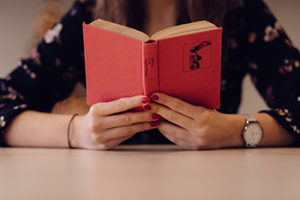3.1: Unit 1 – Close Reading
- Page ID
- 254208

In Unit 1, we will be reading a variety of texts, thinking about them carefully, and then writing about them.
We read for different reasons. We might read a story for entertainment, a textbook to learn a process, news for information, or an editorial to gain perspective.
What if you want to analyze the text itself to make an argument about what it means? What about reading consciously to examine parts of a text in order to discuss or write about it?
Close reading, or critical reading, is a form of active reading in which you break the text into parts and explain the connections in order to support an argument about the meaning of that text. In close reading, you look for:
- organizational patterns in the text.
- the author’s use of literary devices, such as figurative language, images, symbols, character, or setting.
- the author’s word choice (diction) and the tone of the piece.
- the overall theme or meaning the text conveys.
When you write about a text, you are often explaining the theme, or main idea, or examining its meaning. You consider elements of the text, including persuasive devices and literary devices, to support your claim about the text. In essence, you explaining to readers what the text means, using evidence from the text to prove your claim.
This first unit contains several short stories, a poem, an essay, and a historical account from a Spanish explorer in the New World. In this unit, you will perform a close reading of one of these texts to argue about the main idea, or theme, it conveys. The readings and activities will teach you the steps of close reading. In the end, you will learn how to interpret and analyze a complex text and write an organized, well-supported essay that explains your interpretation and analysis to readers.
Modules 2-4 are included in this unit:
- Module 2: Reading – Choose your reading strand, and read the works carefully.
- Module 3: Drafting – Draft a paper in which you interpret and analyze one or more of the readings.
- Module 4: Revising – Revise your paper, considering feedback from your instructor and classmates.
- Adult Blur Book Business. Provided by: freestocks.org. Located at: https://www.pexels.com/photo/adult-blur-book-business-287336/. License: CC0: No Rights Reserved
- Unit 1 - Close Reading. Authored by: Cathy Thwing and Eric Aldrich. Provided by: Pima Community College. License: CC BY: Attribution

